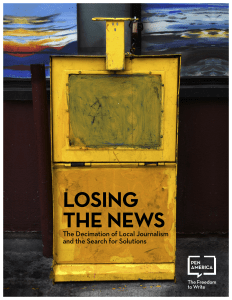Losing the News

Losing the News
Executive Summary
Recommendations
Read the Full Report
Read the Case Studies
What You Can Do
Local News on the Brink
As local news outlets are gutted and shuttered, reporters laid off, publication schedules cut, and resources tightened across the country, Losing the News: The Decimation of Local News and the Search for Solutions sounds the alarm about the existential threat facing local watchdog journalism and proposes big-picture solutions for its revitalization.
At a time when political polarization is growing and fraudulent news is spreading, a shared baseline of facts on the issues that most directly affect Americans is more essential than ever. Without reliable information on how tax dollars are spent, how federal policy affects local communities, and whether local elected officials are meeting constituent needs, how can citizens make informed choices about who should govern?
Confronted with the scope and stakes of the problem, Losing the News ultimately calls for a radical rethinking of local journalism as a public good. The report concludes that reinvigorating local watchdog reporting will require concerted action and an investment of billions of dollars across the philanthropic, private, and public sectors and advocates for a new congressional commission to develop concrete recommendations for how the government can better support a free and independent local press.
READ THE FULL REPORT »
Given the vital role that local news plays as a cornerstone of American democracy, its plight should be the subject of national conversation. Yet most Americans do not yet realize that their local news sources are on the brink of collapse and only a small minority pay for local news.
Drawing on dozens of interviews and a comprehensive analysis of emerging and existing research, Losing the News makes an impassioned case for why local journalism matters for communities and for democracy; maps out the forces driving the local news crisis; takes a clear-eyed look at the ways systemic racial, economic, and geographic inequities in the media landscape are intersecting with the decline of local reporting; spotlights promising adaptations and innovations in the media industry; and proposes big picture solutions. Three powerful case studies written by journalists based in Colorado, Michigan, and North Carolina help illustrate the impact of struggling local news ecosystems on communities.
KEY CONCLUSIONS
- As local journalism declines, government officials conduct themselves with less integrity, efficiency, and effectiveness and corporate malfeasance goes unchecked. With the loss of local news, citizens are: less likely to vote, less politically informed, and less likely to run for office.
- With the shift to digital, the business model for for-profit local journalism has collapsed, as circulation patterns have been upended and tech giants, notably the digital duopoly of Google and Facebook, have siphoned the majority of advertising revenue for content paid for and produced by news outlets.
- Local newspapers, TV stations, and radio stations are being bought and consolidated by hedge funds and media conglomerates and often subjected to relentless cost cutting—leading to coverage that is more national, less diverse, and, in some cases, more politically polarized.
- Newspapers have been hit the hardest, losing over $35 billion in ad revenue and 47 percent of newsroom staff over the past 15 years. Over 1,800 newspapers have closed, leaving more than three million people with no newspaper at all, and more than at least a thousand have become “ghost newspapers,” with little original reporting.
- Because newspapers still provide the majority of original local reporting in communities, their evisceration robs the American public of trusted sources of critical information about health, education, elections, and other pressing local issues.
- Many of the communities traditionally underserved by legacy local media—communities of color, low-income communities, and communities in rural areas—are those most affected by its decline. Finding meaningful, scalable solutions to the local news crisis presents an opportunity to revamp the industry to better represent, reflect, and serve all Americans.
- Across the country, existing and emerging outlets are building out new revenue streams, experimenting with digital-first and nonprofit models, and collaborating rather than competing to better serve communities’ pressing information needs. But in the face of market failure, adaptation and innovation alone cannot address the crisis at the needed scale.
- Philanthropic funding must expand dramatically to make a dent at the local level. Only a small fraction of philanthropic funding for journalism supports local news, and that funding is concentrated on the coasts and a handful of other states and often bypasses smaller and midsize outlets, as well as ethnic- or minority-led ones.
- Legislators and regulators must ensure that technology companies fairly compensate local outlets for the journalism they produce, which including levying an ad revenue tax on platforms like Facebook and Google to fund local watchdog reporting.
- The Federal Communications Commission must roll back recent decisions that enable media consolidation and cost-cutting and clarify and enforce the requirement that media broadcasters produce programming that serves the public interest.
- Given the scope and scale of the problem, a solution is unlikely without dramatically expanding public funding for local journalism, through either reform and expansion of the Corporation for Public Broadcasting or the creation of a new national endowment for journalism. PEN America is calling for a new congressional commission—a Commission on Public Support for Local News—to assess the viability of these options and recommend a path forward.
READ THE EXECUTIVE SUMMARY »
READ THE RECOMMENDATIONS »
READ THE FULL REPORT »
CASE STUDIES
PEN America has enlisted three journalists based in Colorado, Michigan, and North Carolina to write case studies exploring the impact of struggling local news ecosystems on the ground.
- In Detroit, the local news crisis has exacerbated systemic inequality in media coverage and representation. Across the city, the population of which is more than 80 percent black, communities of color feel that pressing issues—from rampant development to water shutoffs—are not being covered critically or in-depth. In response, a new generation of minority-run, digital-native, and nonprofit outlets have emerged. Read the case study »
- In Denver, corporate consolidation has devastated the city’s media. Older and more established news outlets have shriveled, even as the city’s population and economy are booming. Ten years ago, two legacy newspapers had more than 500 working journalists on staff. Today, there’s just one legacy newspaper with 70 journalists on staff. While there has been a major influx of philanthropic funding to support local journalism and myriad new outlets and initiatives have sprung up, their reach and sustainability remain uncertain. Read the case study »
- In North Carolina, Robeson and Cumberland Counties have seen their community-based media outlets shrink, while the regional outlets that used to supplement this coverage have receded. But the fallout is worse for one of these two counties. Read the case study »
READ THE CASE STUDIES:
Colorado, Michigan, and North Carolina »
What Can News Consumers Do?
Concerned about the local news crisis? Here’s what you can do:
- SUBSCRIBE to and join membership programs for local news outlets.
- DONATE to local news outlets (such as public media and nonprofit outlets).
- SPEAK or write to elected and appointed officials about the importance of local news and the need for more public funding and send comments to the FCC about deregulation efforts.
- INFORM news outlets of local stories that need to be told.
- SIGN the petition: Tell Congress to address the local news crisis.
Expert Contacts
 Viktorya Vilk
Viktorya Vilk
Manager of Special Projects, Free Expression Programs
Contact »
James Tager
Deputy Director, Free Expression Research and Policy
Contact »
Nora Benavidez
Director of U.S. Free Expression Programs
Contact »






